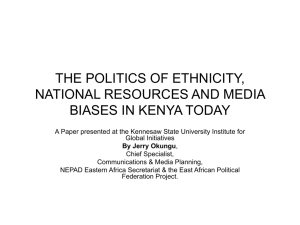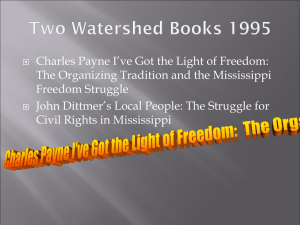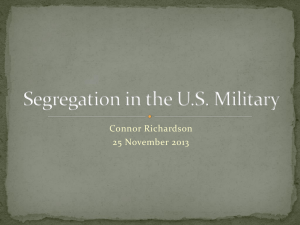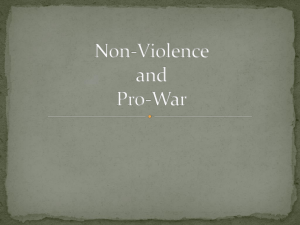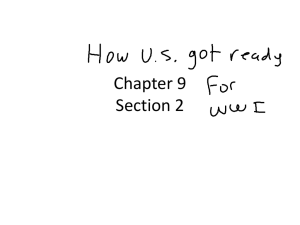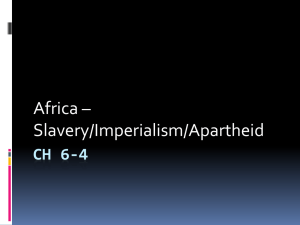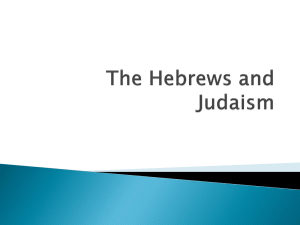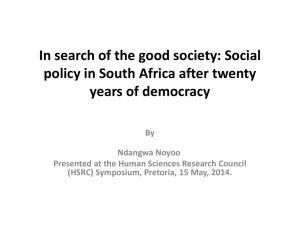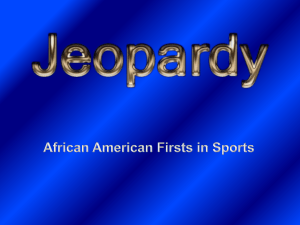Independence Movements
advertisement
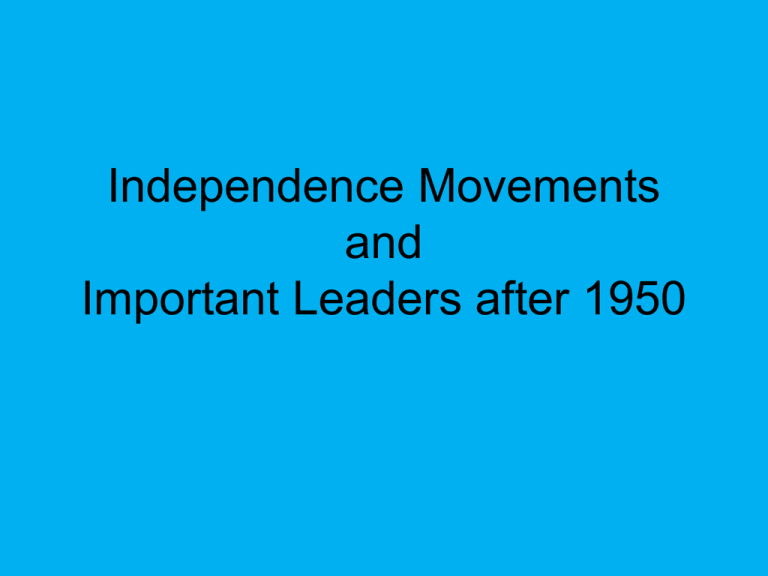
Independence Movements and Important Leaders after 1950 Who led the independence movement in India? Mohandas Gandhi led the Indian Independence movement. What strategies did Ghandi use during the movement for Indian Independence? Ghandi used non-violence, civil disobedience and passive resistance. Civil Disobedience 1. Civil disobedience is the assertion of a right which law should give but which it denies. 2. Civil disobedience presupposes willing obedience of our self-imposed rules, and without it civil disobedience would be a cruel joke. 3. Civil disobedience becomes a sacred duty when the State becomes lawless and corrupt. 4. Civil disobedience means capacity for unlimited suffering without the intoxicating excitement of killing. 5. Disobedience to be civil has to be open and nonviolent. 6. Disobedience to be civil implies discipline, thought, care, attention. 7. Disobedience that is wholly civil should never provoke retaliation. 8. Non-cooperation and civil disobedience are different but branches of the same tree called Satyagraha (truth-force). Passive Resistance • Passive resistance is a method of securing rights by personal suffering; it is the reverse of resistance by arms. • Passive resistance is a misnomer for nonviolent resistance. It is active nonviolent resistance. • Jesus Christ, Daniel and Socrates represented the purest form of passive resistance or soul force. Noncooperation • Noncooperation means refusal both to help the sinner in his sin and to accept any help or gift from him until he has repented. • Noncooperation is a measure of discipline and sacrifice and it demands respect for the positive views. • Nonviolent noncooperation with evil means cooperation with all that is good. • Noncooperation is intended to pave the way to real, honorable and voluntary cooperation based on mutual respect and trust. • Noncooperation is not a hymn of hate. • My Noncooperation is with methods and systems, never with men. • Nonviolence is the rock on which the whole structure of noncooperation is built. Non-Violence • Non-violence is a weapon of the strong. • Non-violence is not a garment to put on and off at will. Its seat is in the heart, and it must be an inseparable part of our being. • Anger is the enemy of non-violence and pride is a monster that swallows it up. • I have nothing new to teach the world. Truth and Non-violence are as old as the hills. All I have done is to try experiments in both on as vast a scale as I could. • Non-violence is the greatest force at the disposal of mankind. It is mightier than the mightiest weapon of destruction devised by the ingenuity of man. • Non-violence requires a double faith, faith in God and also faith in man. • Non-violence, which is the quality of the heart, cannot come by an appeal to the brain. What two issues dominated Indian politics after World War II? • Indian independence from Britain and India’s Muslims’ concerns about their place in a country dominated by Hindus were the two issues that dominated Indian politics after World War II. How was the tension between Muslims and Hindus in India ultimately resolved. • India was partitioned (divided into 2 nations) in 1947. One nation was Pakistan where Muslims are the majority and the other was India where Hindus are the majority. What were some results of Indian Independence? • As a result of Indian independence, there were mass migrations. Many Hindus in Pakistan move to India and many Muslims in India moved to Pakistan. • There were often deadly clashes between Hindus and Muslims. • Gandhi was assassinated in 1948 by a Hindu who was upset over the partition. How were India and Pakistan further divided? • In 1948, the large island off the coast of India (Ceylon) became independent. It was renamed Sri Lanka. • In 1971, the eastern section of Pakistan became Bangladesh. Who was Jawaharlal Nehru? Jawaharlal Nehru •was an Indian statesman who was the first and longest-serving Prime Minister of India, from 1947 until 1964. •One of the leading figures in the Indian independence movement, Nehru was elected by the Indian National Congress to assume office as independent India's first Prime Minister, and re-elected when the Congress Party won India's first general election in 1952. •As one of the founders of the Non-Aligned Movement, he was also an important figure in the international politics of the post-war era. •1950 Constitution prohibited caste discrimination •Supported western style industrialization Who was Indira Gandhi? Indira Gandhi • Closer relationship between India and Soviet Union during the Cold War • Developed a nuclear program Indira Gandhi •born Indira Nehru to Jawaharlal Nehru •was the third Prime Minister of the Republic of India for three consecutive terms from 1966 to 1977 and for a fourth term from 1980 until her assassination in 1984, a total of fifteen years. •India's only female prime minister to date, she remains the world's longest serving female Prime Minister as of 2011. •She was also the only Indian Prime Minister to have declared an emergency in order to 'rule by decree' and the only Indian Prime Minister to have been imprisoned after holding the office. Why did African independence movements gain success after World War II? • Africans fought alongside Europeans during World War II and resented not being granted independence after the war. • After World War II, the UN charter supported the right of self-determination. • Africans had a lot of resentment toward imperial rule and economic exploitation. • There were many peaceful and violent protests against colonial rule. • Name the only countries in Africa that were independent one year after the end of World War II. (1946) Egypt, Liberia, Ethiopia, and South Africa were the only independent African nations in 1946. http://upload.wikimedia.org/wikipedia/commons/7/75/Africa.gif What role did the superpowers (U.S. and the USSR) play in African independence movements? • The US supported non-communist factions in Africa while the USSR supported communist groups. • For example, in Angola, Cuban troops and Soviet supplies supported the Marxist faction, while the United States supplied and financed an anti-socialist group. What were the three patterns of independence efforts in Africa? • Independence efforts in Africa followed three patterns: – Peaceful transition, – violent transition or violence following transition due to conflicts among Africans, – and three-sided conflict between European settlers, native Africans, and colonial powers Why were West African countries like Ghana able to gain their independence peacefully? • Colonies with a small European population and minimal tensions between African groups within the colony were able to gain independence peacefully. • This made the transition to independence easier. • All the colonial power had to do was identify the people who would assume power and make plans for turning the colony over to them. Who led Ghana’s Independence Movement? Kwame Nkrumah KwameNkrumah (1909-1972) -First president of Ghana (1957), a former British colony -Advocate of Pan-Africanism -Founding member of the organization of African Unity (OAU), in 1963 -Very familiar with U.S.; had attended Lincoln University in PA (1935-1942) -Strongly influenced by the ideas of Marcus Garvey and W.E.B. DuBois -Had led nonviolent resistance (boycotts, strikes, etc.) to British rule in the Gold Coast in 1949-1950; arrested and jailed by British for over a year -Believed that socialism reflected African ideals more than capitalism -While in power, ruled essentially as a dictator; he outlawed strikes, set up a one party state -Overthrown in a coup d’etatin 1966 Why is Ghana’s independence so significant? Ghana was the first sub-Saharan African nation to break from colonialism. What was Ghana called before independence? • Ghana was called the Gold Coast before it gained independence. • Before independence, there were nationwide strikes and boycotts. • Leaders, like Nkrumah, were imprisoned. Why were some independence movements like the one in Nigeria more violent? • Some independence movements were violent because –There were conflicts among the different African ethnic groups –After independence, countries with a variety of ethnic groups often fell into civil war –This was partially due to the fact that the boundaries of African nations that Europeans had drawn disregarded the views of the African groups involved What are the major ethnic groups and religions in Nigeria? • The three largest and most influential ethnic groups in Nigeria are the Hausa, Igbo, and Yoruba. • The country is roughly split in half between Christians and Muslims. • Nigeria is the 8th most populated country in the world. • Because of nationalism and demands for independence, Britain gradually gave Nigeria their independence. • Explain the three-sided conflicts that took place in places like Algeria, Kenya, and South Africa. • In African countries with a large European population, European settlers resisted both the desires of native populations and the colonial power’s plans to establish African majority rule. Why was France so reluctant to give up Algeria? • France saw Algeria as legally part of France, like Hawaii is to the U.S. France allowed their other colonies like Tunisia and Morocco to gain independence so that they could focus on keeping Algeria. The Algerian war for independence lasted from 1954-1962. What is apartheid? Apartheid was the South African government’s policy of separation of the races. -Apartheid refers to discriminatory policies enforced in South Africa during much of the 20thcentury -After South Africa had gained its independence from Great Britain, several whiteminority governments, passed a series of laws that drastically curtailed the rights of Africans and other non-whites to vote, go to university, etc.; these governments also instituted laws requiring the separation of whites and blacks -Various black nationalist groups, led by the African National Congress (or ANC), formed in opposition to both the government and these segregationist policies (referred to collectively as apartheid) Who was Nelson Mandela? • Nelson Mandela was an important leader in the struggle against apartheid and eventually became the first black president in South Africa. -Mandela was one of the leaders of those opposed to the Apartheid regime in South Africa -He initially favored non-violent protest in opposition to to South Africa’s apartheid system -Later, he became a leader of the ANC’s armed wing -Arrested in 1961 for sabotage, he spent more than 27 years in prison -After negotiations with Pres. F. de Klerk in the late 1980s, he was released from prison -He was elected South Africa’s first African president in 1994 -In 1999 he retired Who led Kenya’s movement for Independence? -First prime minister (1963-1964), then president of Kenya (1964-1978) -A member of the Kikuyu (or Gikuyu) tribe, Kenyatta was born in British East Africa -Trained as a carpenter, he joined the Kikuyu Central Association (or KCA) in 1924 and eventually became the organization’s leader -In the 1930s he attended college in both England and the Soviet Union -In 1946 he became a teacher in Kenya -In 1947 Kenyatta became president of the Kenya African Union (or KAU) and calls for independence for Kenya -In 1951 Kenyatta is arrested and put on trial for allegedly being involved in the strongly anticolonialist Mau Mau rebellion; he is convicted and forced to spend 7 years in prison -In 1963 he becomes Kenya’s first post-colonial leader; he is pro-Western and moderate but also authoritarian; he effectively rules Kenya as a oneparty state -In the picture to the right, Kenyatta is speaking with Thurgood Marshall, a future U.S. Supreme Court justice Jomo Kenyatta • Describe the major steps toward Kenya’s independence and Jomo Kenyatta’s role in the movement. • Kenya’s European population held most of the economic and political power, but made up less than 1% of the population. • Jomo Kenyatta was an important leader of the independence movement in Kenya. • His efforts were interrupted by the Mau Mau rebellion (19521960) in which 70 Europeans were killed and 18,000 black Africans were killed. • Kenyatta was jailed in 1953 and released in 1961. • Kenyatta became Kenya’s first Prime Minister in 1963. • Compare the boundaries created by Europeans in Africa to the ones created by them in the Middle East. • Just like the boundaries in Africa, the boundaries for the middle eastern mandates were artificial. • And just like in Africa, conflict and violence often erupted among the different groups that were united by these artificial boundaries created by the Europeans. What was the mandate system? • Mandates were the middle eastern Arab nations of Lebanon, Syria, Iraq, Transjordan and Palestine. • These nations thought that they would be granted independence after World War I since they helped the allies win. • Instead, they remained “temporary” possessions of Britain and France. What were the results of the United Nations’ decision to end the mandate system? • Mandates in the Middle East were Iraq, Palestine, Transjordan, Syria and Lebanon. • Many of the conflicts in the Middle East are between – Arab Muslims and Non-Arab Muslims, – Arabs and Jews and – Sunni and Shiite Muslims. • Islamic fundamentalists who want to restore the law of the Koran as the basis for government, law, and behavior, pose a threat to secular governments. Describe some of the ethnic and religious diversity of the Middle East. • Arabs, Turks, Persians, and Kurds are the largest ethnic groups in the Middle East. • The dominant languages spoken are Arabic, Turkish, Farsi, Kurdish, and Hebrew. • The three major religions are Islam, Christianity, and Judaism. (90% of the people are Muslim.) • Israel is the only nation in the Middle East that does NOT have a Muslim majority. • Most Muslims are Sunnis while Shiites dominate in Iran and are a large faction in Iraq. What is Zionism? Zionism is the movement to establish a Jewish homeland. Who was Gamal Abdel Nasser? Gamal Abdel Nasser (1918-1970) -Nasser was the charismatic leader of Egypt from 1956 to 1970 -A former Air Force officer, he took power in a coup d’etat and steered Egypt on a more nationalist and anti-colonialist course -His success in facing down the British, the French and the Israelis in the 1956 Suez Crisis won him wide acclaim in the Third World -He was less successful in the Six Day War against the Israelis in 1967; Egypt lost the war and had to give up the Sinai and the Gaza Strip to Israel -His attempt to unify Syria and Egypt in the United Arab Republic (UAR) was short-lived -He oversaw some major rebuilding projects, such as the Aswan Dam, and received aid from the Soviet Union, which did not please the U.S. Aswan High Dam Aswan High Dam The Suez Canal Crisis (1956) -This canal, built in the late 19thcentury, was strategically important to Great Britain and many other countries -When Nasser announced plans to nationalize it, Great Britain, France, and Israel became concerned and sent in troops, precipitating the Suez Crisis -U.S. President demanded that these countries withdraw their troops -Nasser was able to claim success for standing up to these other powers 6 Day War •also known as the 1967 Arab-Israeli War or the Third ArabIsraeli War, •was fought between June 5 and June 10, 1967, by Israel and the neighboring states of Egypt (known then as the United Arab Republic [UAR]), Jordan, and Syria. •The war began with a large-scale surprise air strike by Israel on Egypt. •The outcome was a swift and decisive Israeli victory. •Israel took effective control of the Gaza Strip and the Sinai Peninsula from Egypt, the West Bank and East Jerusalem from Jordan, and the Golan Heights from Syria. •The status of the territories captured by Israel during the war and the concurrent refugee problem are central concerns in the ongoing Israeli–Palestinian conflict, raising issues in international law, and having far-reaching consequences in global affairs. Who was Golda Meir? Golda Meir (1898-1978) -Golda Meir was one of Israel’s more successful leaders during the 1960s and 1970s -She was Prime Minister of Israel from 1969 to 1974 -A member of the Labor Party, she oversaw many of the reforms that enabled Israel to modernize and become as advanced economically as some Western nations - Led Israel to victory in Yom Kippur War Yom Kippur War (1973) •also known as the 1973 Arab-Israeli War and the Fourth Arab-Israeli War, •was fought from October 6 to 25, 1973, between Israel and a coalition of Arab states led by Egypt and Syria. •The war began when the coalition launched a joint surprise attack on Israel on Yom Kippur, the holiest day in Judaism, which coincided with the Muslim holy month of Ramadan. Significance of Yom Kippur War •The Arab World, which had been humiliated by the lopsided rout of the Egyptian-Syrian-Jordanian alliance in the Six-Day War, felt psychologically vindicated by early successes in the conflict. •In Israel, despite impressive operational and tactical achievements on the battlefield, the war effectively ended its sense of invincibility and complacency. •The war also challenged many American assumptions; the United States initiated new efforts at mediation and peacemaking. These changes paved the way for the subsequent peace process. •The Camp David Accords that followed led to the return of the Sinai to Egypt and normalized relations—the first peaceful recognition of Israel by an Arab country. •Egypt continued its drift away from the Soviet Union and left the Soviet sphere of influence entirely. Who was Deng Xiaoping? Deng Xiaoping • Reformed communist economy to market economy which led to rapid economic growth in China • Communist control of government continued Who was Margaret Thatcher? Margaret Thatcher • British Prime Minister • Free trade and less government regulation of business • Close relationship with U.S. and U.S. foreign policy • Asserted United Kingdom’s military power

